How to compose a chorale prelude (3)
In this series of posts I explore a route to create a choral prelude. With Johann Gottfried Walther's choral prelude to the first verse of "Nun komm der Heiden Heiland" as a model I formulated at a simple procedure to create a similar composition and applied it to the first phrase of the same choral melody. The procedure developed so far is:
- take an existing choral prelude with the choral melody in the soprano voice
- identify the main harmonic notes in the bass voice
- decide where you want the main 'mobile' role to be, in the tenor voice or the bass voice (or a combination)
- write an introductory phrase to establish the tonal key.
- write the parts, making sure the bass voice hits the main harmonic notes at the right time.
- create a transitional phrase, flexible enough to be used several times; possibilites are to use fore-imitation, or to use elements from the introductory phrase
The way I arrived at this procedure, and the intermediate results are described in the first two posts.
- https://steempeak.com/classical-music/@partitura/how-to-compose-a-choral-prelude-1
- https://steempeak.com/classical-music/@partitura/how-to-compose-a-choral-prelude-2
The actual proces if of course more chaotic then appears from those two posts, or from this post. The real proces is more a mix of sketching, erasing, engraving, playing and looks a bit like in the next picture.
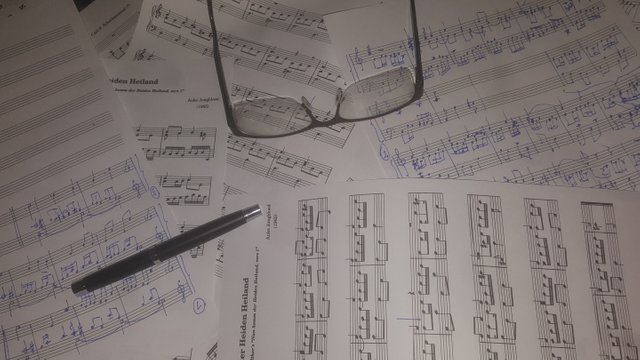
The intermediate results so far consists of three fragments of pieces or compositions based on the first two phrases of the choral melody "Nun komm der Heiden Heiland"). They look like this:
The piece with the bass voice as main 'mobile' part
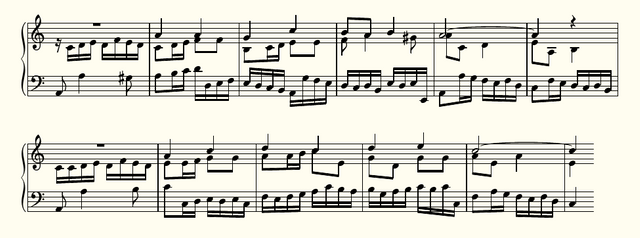
The piece with the tenorvoice as main 'mobile' part

The piece with the ternary rythm
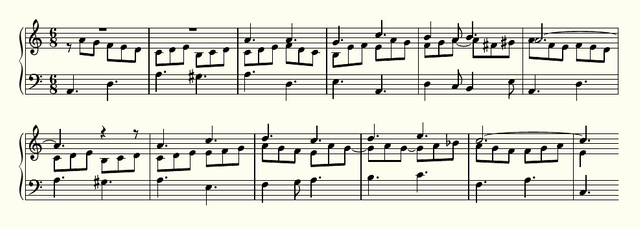
At the end of the second post I included recordings of each of these three fragments. The choral is only two more phrases long. In this post ïll treat the remaining two fragments. The first of these two fragments looks like this in Walther's original. As in the previous two posts I have circled the melody notes with green, and the main harmonic notes in the bass voice with red.
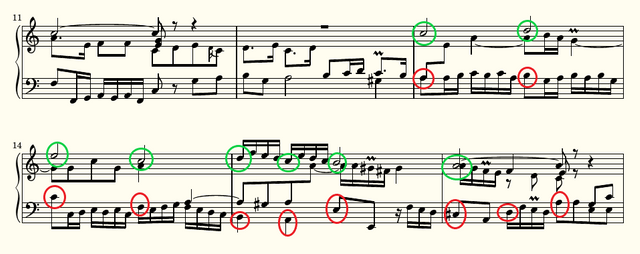
Reduced to only melody and harmonic notes, that gives.

A thing to note in Walther's original is that the second phrase ends in a C major chord and that the third phrase starts on an a minor chord. Walther's transition phrase elegantly moves the music from C major to a minor. Before I can start with writing an extended bass voice and filling in the tenor voice to the thid chorale melody phrase, I have to write a transition phrase between the end of the second melody phrase and the start of the third melody phrase. And I have to make the same transition from C major to a minor. Ideally as elegantly as Walther does it. The transition phrase doen not only have to make the modulation, there is another (self imposed) constrained . The objective is to use the musical material of the transition phrase (or a variation of it) between the first two melodic phrases. This serves two main purposes: I don't have to come up with something new and it creates unity in the pieces. For the piece with the bass voice as main 'mobile' part I created this variation on the first transition phrase:

And for the piece with the tenor voice as main 'mobile' part, I created this variation on it's first transition phrase:

The process of creating parts for the tenor and the bass voice has been treated in the previous two posts. The process is the same here so I'll just present the results for both pieces:
The piece with the bass voice as main 'mobile' part

The piece with the tenor voice as main 'mobile' part

Three phrases of the choral melody done and only one more to go. It so happens that the fourth phrase of this particular choral melody is the same as the first phrase. And Walther uses in his piece for that fourth phrase the same music as he used for the first phrase:
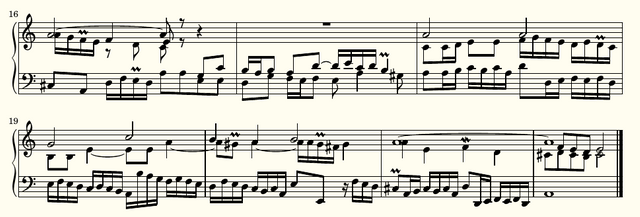
And as I wrote in my first post: my goal is not to be original, my goal is just to do as Walther does. So, for my pieces I'm going to do the same and just use the music I created for the first phrase. So the only thing left to do is to write a transition phrase from the third phrase to the last one. And again as Walther does, the introductory phrase will become part of this transition phrase. So here are the third phrase again plus the transition phrase to the fourth phrase (inclusing the introductory phrase) for both pieces.
The piece with the bass voice as main 'mobile' part

The piece with the tenor voice as main 'mobile' part

After these fragments follows the same music as at the start of the piece. And that leaves with only one thing to do: bring an end to the music. Walther writes just to bars to end his piece. The soprano note is tied over in these closing bars. And to what Walther does I'll add that I should use (again) the material of the transition phrases. So the elements for the closing phrase are:
- keep it short, just a few bars
- the last melody note is tied over these bars
- use the material of the previous transition phrases.
From these elements I created the following two closing phrases:
The piece with the bass voice as main 'mobile' part

The piece with the tenor voice as main 'mobile' part

Glueing all grafment shown above together and inserting the music of the first melody phrase, the music created for both pieces in this post looks like this:
The piece with the bass voice as main 'mobile' part
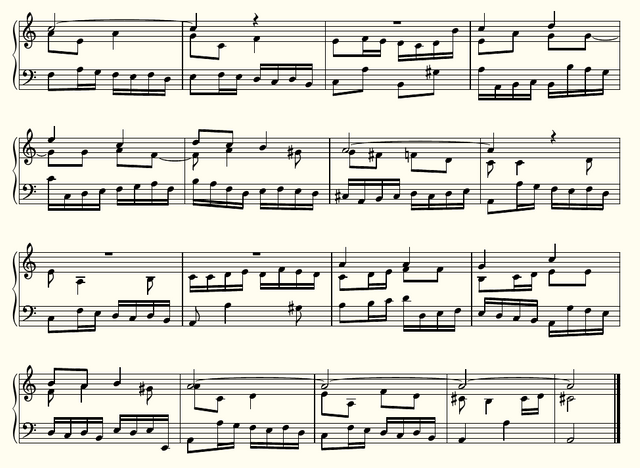
The piece with the tenor voice as main 'mobile' part
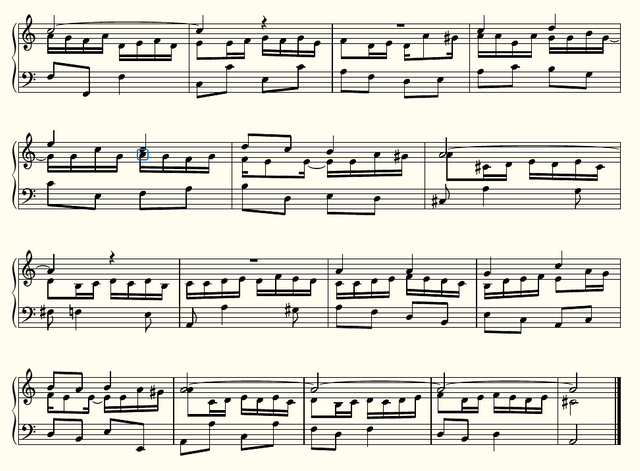
Taking into account the ideas learned from working on the last two phrases of the choral melody in this post, my procedure for writing a choral prelude has become:
- take an existing choral prelude with the choral melody in the soprano voice
- identify the main harmonic notes in the bass voice
- decide where you want the main 'mobile' role to be, in the tenor voice or the bass voice (or a combination)
- write an introductory phrase to establish the tonal key.
- write the parts, making sure the bass voice hits the main harmonic notes at the right time.
- create a transitional phrase, flexible enough to be used several times; possibilites are to use fore-imitation, or to use elements from the introductory phrase
- reuse material whenever possible
- create a closing phrase:
- keep it short, just a few bars
- the last melody note is tied over these bars
- use the material of the previous transition phrases.
Applied to my third test case this procedure leads to a finished composition as well. See the last image below. With the pocedure outlined and summarized in this post, and with these three compositions as sample material, anyone who is interested in doing the same should be in a good position to actually do the same.
For a recording of these three preludes, see (and hear) this post: https://steempeak.com/secretsoforganplaying/@partitura/how-to-play-a-chorale-prelude
I now have three completed compositions and I know that with the procedure outlined and summarized above I can write more. And that is actually quite amazing. In my life I've tried composing piece like this before, but it never really was a success. It is with the idea I had last week to take a model and methodically analyse how it was written, that I was able to come up with these three compositions. And I'm actually quite proud of them. No, they are not very original. But they are not bad either. With this procedure I can actually compose more of them, based on different models and different choral melodies.
A three part composition with the choral melody in the soprano voice is just one of dozens techniques to write a choral prelude. As a next step, I am going to take a model that emplys a different technique, and analyse it in the same way as I have done with Walther's "Nun komm der Heiden Heiland, verse 1". And that will be the subject of a future post.
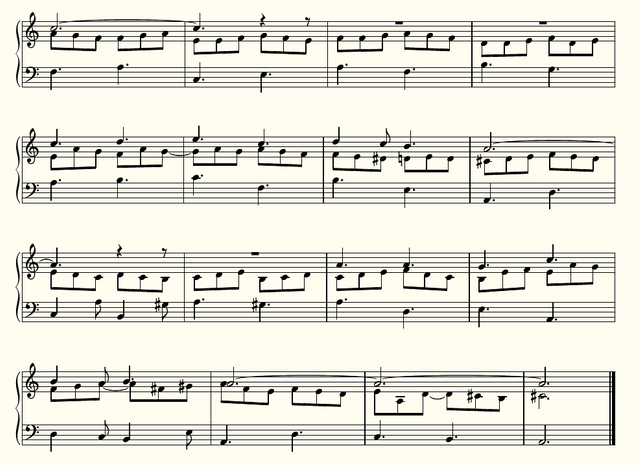
You can support me using Steem Basic Income

Resteemed, your post will appear in the next curation with a SBD share for you!
Your post has been supported and upvoted from the Classical Music community on Steemit as it appears to be of interest to our community. We also support jazz and folk music posts!
If you enjoy our support of the #classical-music community, please consider a small upvote to help grow the support account!
You can find details about us below.
The classical music community at #classical-music and Discord. Follow our community accounts @classical-music and @classical-radio or follow our curation trail (classical-radio) at SteemAuto!
Delegation links: 10SP, 25SP, 50SP, 75SP, 100SP, 150SP, 200SP, 250SP, 500SP, 1000SP
This post was shared in the Curation Collective Discord community for curators, and upvoted and resteemed by the @c-squared community account after manual review.
@c-squared runs a community witness. Please consider using one of your witness votes on us here